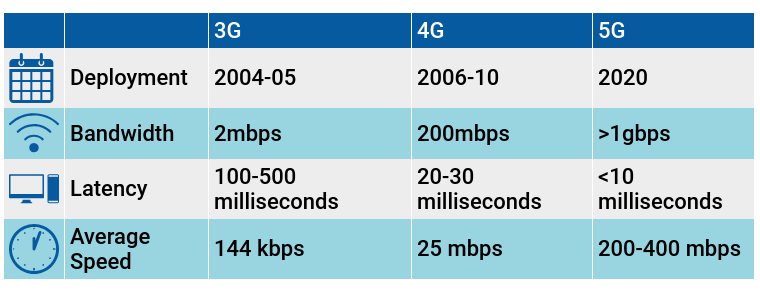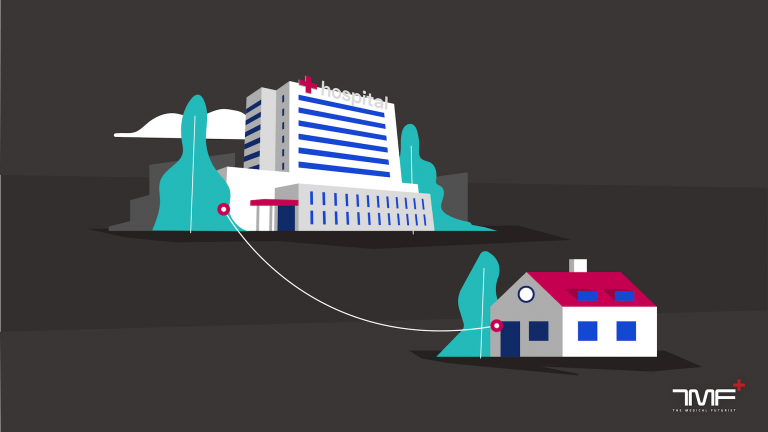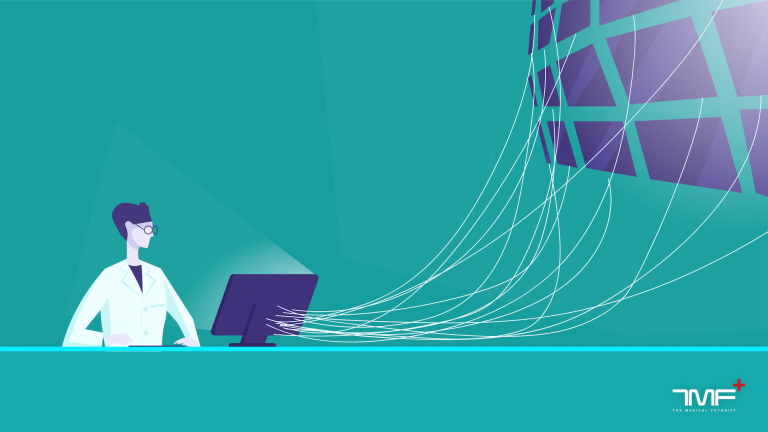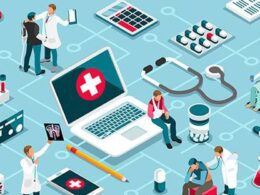The Medical Futurist
28 December 2021
The digitisation of hospital systems is yet another result the pandemic’s challenges have brought upon us.
The urgency for extra bandwidth needed for remote care solutions, hospital IoT deployments, telehealth consultations or the operations of robots and robotic systems made it clear: hospitals need better access to networks, and 5G is an obvious solution.
Indeed, 5G in healthcare will finally allow the building of infrastructure suitable for the interplay of health sensors, algorithms, and smart devices, for the smooth operation of telemedicine — or even for providing a way for parents to interact with babies in incubators.
5G networks can provide the transformative technological background healthcare needs today. Let’s see how.
- The advantages of 5G
- Why is 5G interesting for healthcare?
- What if you could operate on brains remotely?
The advantages of 5G
5G promises high bandwidth, low latency and low power-low cost in healthcare. It will open the gate to a flood of new inventions and the implementation of ideas that have already been in the public consciousness, such as stable augmented reality or truly immersive virtual reality platforms powered by networks.
Hospitals also equip themselves for change.
Over three-quarters of hospital executives said they’re “very or somewhat likely” to implement 5G for telehealth and remote patient monitoring; and more and more hospitals are enabling the technology within the walls, smartening up their infrastructure — or being built entirely with these goals in mind.
The FDA is also regularly publishing guidelines on 5G.
Over three-quarters of hospital executives said they’re “very or somewhat likely” to implement 5G for telehealth and remote patient monitoring;
and more and more hospitals are enabling the technology within the walls, smartening up their infrastructure — or being built entirely with these goals in mind.
5G networks will allow devices to download data at more than 1 gigabit per second (1gb/s). That is at least 10 to 100 times faster than today’s 4G services. As today’s hospitals need to gear up for the next challenges in healthcare, the institutions use bandwidth for everything: from operations to patient communication.

5G networks will eclipse their predecessors in at least three areas: capacity, latency, and customization.
The first one refers to both the increase in speed and bandwidth, as well as the ability to connect a lot more devices at once, which is a prerequisite for the Internet of Things (IoT) networks. At the moment, smart sensors, connected devices, and other IoT tools are putting current networks under increasing strain. While 4G supports only 4000 devices per square kilometre, 5G can support up to a million devices. Now, that’s an insanely huge difference.
The second dimension, latency, or in other words, the responsiveness of a given system, will become key for the advancement of remote controlling in many sectors.
In a 5G network, that round-trip time will fall to around one millisecond. That will be extremely important in the development of telehealth, especially telesurgeries.
And finally, the third dimension of 5G is the appearance of customized networks.
This one will prove to be truly revolutionary — for providers, at least, not necessarily for the average consumer. This means that instead of customers connecting to the same networks, operators will carve out subnetworks with features tuned to specific requirements. For example, there could be a network for telehealth emphasising the lowest latency rate possible, while fast download speed and wide geographical coverage for the transmission of medical images.

Why is 5G interesting for healthcare?
Although 5G will have an impact on average consumers, too, due to the increase in speed and bandwidth, the real beneficiaries of the technology will be businesses and sectors — such as healthcare.
Healthcare will benefit from 5G technology from countless aspects; it is basically the field that might experience the most changes.
And not in the distant future: hospitals in Finland have already deployed a range of such solutions for years, from a way to do stroke rehab through VR and smart bandages that track your healing to a way for parents to interact with babies who are stuck in incubators. But that’s just the beginning.
hospitals in Finland have already deployed a range of such solutions for years, from a way to do stroke rehab through VR and smart bandages that track your healing to a way for parents to interact with babies who are stuck in incubators. But that’s just the beginning.
Adding a high-speed 5G network to existing hospital architectures can help quickly and reliably transport huge data files of medical imagery, which can improve both access to care and the quality of care.
For example, at the Austin Cancer Center, the PET scanner generates extremely large files — up to 1 gigabyte of information per patient per study.
When someone needs a remote consultation, it could be difficult to send over such a huge file quickly with the currently existing networks. In the future, that might change for the better and lead to more frequent remote consultations.
Adding a high-speed 5G network to existing hospital architectures can help quickly and reliably transport huge data files of medical imagery, which can improve both access to care and the quality of care
In order to make patients the point of care, accurate pocket-sized connected devices are needed that constantly monitor the state of the patient and notify the physician in case of values out of the normal range. 5G technology could enable such health IoT networks to operate in a stable and highly reliable way.
In order to make patients the point of care, accurate pocket-sized connected devices are needed that constantly monitor the state of the patient and notify the physician in case of values out of the normal range.
5G technology could enable such health IoT networks to operate in a stable and highly reliable way.
According to Anthem, 86 percent of doctors say wearables increase patient engagement with their own health. Additionally, these devices are predicted to decrease hospital costs by 16 percent in the next five years.
According to Anthem, 86 percent of doctors say wearables increase patient engagement with their own health. Additionally, these devices are predicted to decrease hospital costs by 16 percent in the next five years.
Both statistics are likely to increase further in the coming years. Although expectations regarding health sensors, wearables, and other connected devices are already high to transmit often real-time data to doctors about the user’s health, networks and/or mobile technology cannot show up the performance matching these expectations at the moment. That’s why 5G technology could be a game-changer.
Parallel to the advancement of health IoT networks and devices, the possibility to create big data-powered smart algorithms in healthcare will also increase.
Using 5G infrastructure, it will be much easier and more reliable to use artificial intelligence software analyzing real-time patient data sent to could platforms.
Parallel to the advancement of health IoT networks and devices, the possibility to create big data-powered smart algorithms in healthcare will also increase.
Using 5G infrastructure, it will be much easier and more reliable to use artificial intelligence software analyzing real-time patient data sent to could platforms.
The real era of A.I. will come with the advent of 5G technology.

What if you could operate on brains remotely?
One of the most important aspects of 5G technology is that it enables telemedicine, and more specifically, telesurgery due to the very low latency that it can achieve.
Experts say that 5G’s ability to penetrate farther than current wireless networks could finally enable telesurgery, bringing necessary operations to those who need it more.
It supports the use of advanced technological solutions in surgery and other medical procedures.
In China, a 5G-powered medical robot recently performed remote brain surgery — in a matter of 60 seconds!
China is also preparing to deploy remote surgical robotic services for the 2022 Winter Olympics.
The speed and reliability of 5G networks also change medical transportation and emergency response. Drone deliveries, smart ambulances are becoming necessities to provide even faster and better care — this now being more important than ever.
5G-connected ambulances are enabling life-saving communication tools for the patient to receive real-time specialized remote support while still in the ambulance. Sounds too distant? It’s happening already in many places in the world from Australia to Spain or the UK.
The speed and reliability of 5G networks also change medical transportation and emergency response. Drone deliveries, smart ambulances are becoming necessities to provide even faster and better care — this now being more important than ever.
5G technology does not encompass a health technology development but it will have a tremendous impact on the medical sector.
Health sensors, wearables, connected devices as well as smart algorithms relying on big data sets cannot be dependent on the fragile nature of 4G networks or home bandwidth. Especially when it comes to electronic devices connected to patient data, users want to see stability, reliability, and constant performance.
5G technology does not encompass a health technology development but it will have a tremendous impact on the medical sector.
Health sensors, wearables, connected devices as well as smart algorithms relying on big data sets cannot be dependent on the fragile nature of 4G networks or home bandwidth.
Especially when it comes to electronic devices connected to patient data, users want to see stability, reliability, and constant performance.
5G could provide exactly that.
Originally published at https://medicalfuturist.com












